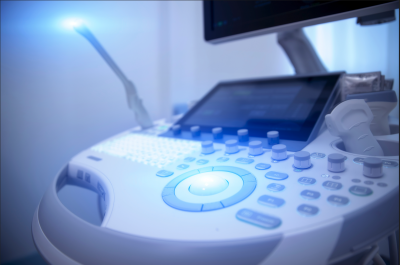
Written by

Cranfield, UK, 17th April 2023 – The British Institute of Radiology AI Congress returned for 2023, bringing together a considerable number of thought leaders and pioneers across NHS England, NHS Scotland, and the UK. Several prominent European figures were also present, but representation from AI vendors was weak, especially from the UK. For those present, vendors were either ramping up operations in the UK or looking for an avenue to enter this market. In this insight, we highlight some of the key trends seen at the show, from both thought-leader presentations and vendor exhibitions.
Orchestrating the deployment of AI
One of the key trends in the medical imaging AI market, and dominant themes at recent shows including RSNA 2022 and ECR 2023, is AI orchestration platforms. It was of no surprise that AI platforms were discussed at great length during the BIR congress, ranging from orchestrating AI within the workflow to the NHS’s platform initiative.
At present, most AI platforms are focused on addressing the last-mile challenges of AI which encompasses back-end deployment, front-end integration, and algorithm orchestration. Looking beyond the short-term roadmap, which we have discussed extensively before, one of the newer emerging themes was platforms that work across pathways, not limiting themselves to just one technology or product. Such evolution could lead to multi-speciality platforms or platforms that span across all care delivery pathways of the hospital, using the benefits of technology whilst streamlining care coordination, ultimately leading to improving patient outcomes. However, we are still a long way off from achieving this long-term vision, and algorithm validation and post-deployment analytics present as more pertinent issues that platforms need to solve in the short term.
NHS Scotland demonstrated forward thinking in the AI field, leaving NHS England looking slow to innovate, with disparities between the two boards evident. The installation of a national PACS in Scotland already puts it ahead as a base for AI integration; this would be a considerably harder and more complex undertaking for NHS England, though recent vanguard schemes and regional implementations is a move towards PACS consolidation, albeit a slow move. In Scotland, issues of fragmented AI deployment across Trusts were highlighted, and a platform approach was championed. The complexity of scaling up AI use over different clinical systems, departments and disciplines is significant and NHS Scotland has put forward a vision to deploy AI platforms from the get-go to reap the benefits in the long term.
With that being said, NHS England is taking steps in the right direction, trialling its own AI deployment platform with two algorithms incorporated to start. Due to the considerable number of AI platforms that exist commercially, it is surprising that the NHS has chosen a native AI platform approach. Time, resources, and money, in a system already at breaking point, could have been saved by partnering with an established platform vendor, with patients subsequently benefiting sooner.
Collaboration in the face of regulatory challenges
The streamlined and efficient engine of the FDA has propelled the US to become one of the first markets AI vendors look to target as they expand internationally. This has been compounded by stagnation in CE Marks being awarded as the European Union (EU) has shifted from the Medical Devices Directive (MDD) to the Medical Devices Regulation (MDR).
Having left the EU and initiated its own regulatory framework (UKCA), there is a greater need for industry collaboration in the UK, facilitated by the NHS or government, to implement AI. To keep the UK and European markets at the forefront of innovation, hurdles within the regulatory process need to be addressed to keep AI vendors on board.
Philips pushed forward the idea of collaborating with both healthcare providers and AI developers to drive departmental and hospital AI implementation and produce more impactful ROI. Their vision to forge more tightly knit collaborations with AI vendors across clinical use cases could produce an immensely powerful solution that could aid long term transformation of healthcare systems. As ever though, executing on such a vision is the difficult part.
The NHS also reiterated initiatives such as the NHSX AI Awards, which has funded companies such as Aidence and Qure.ai, enabling the acceleration of their product testing and evaluation. Furthermore, the collaboration between Trusts across the wider NHS landscape to deploy a unified AI platform would provide advantages including the ability to compare AI tool performance between trusts, measure AI performance at a national level and share safety issues between users. Beginning with a platform-based approach over the deployment of single-use applications is essential to aid the scaling up of AI nationwide. AI solutions, such as those developed by Aival, could be deployed to counteract the increase in workload to validate AI tools across trusts and ensure continued performance post-deployment.
Regulatory bodies were met with disproval due to the recent turmoil with CE Mark regulations; however, similarly, they were keen to collaborate with AI vendors to streamline the regulatory guidance for AI and digital health technology companies and avoid vendors shifting their focus to attain FDA clearance instead.
This was still met with hesitancy and the consensus was the European and UK regulatory processes are very cumbersome. A combination of the lack of awarding regulatory bodies, the shift from MDD to MDR approvals and the long wait time for new approvals have left a sour taste in the mouths of vendors. There was also plea from regulatory bodies for vendors to collaborate with them to improve the regulatory process and prevent the shift in vendors obtaining FDA approval instead.
The value proposition of AI
For the NHS, in the short-term, leveraging technology to address the shortage of radiologists and reducing the backlog of scans remains one of the more pressing concerns. One of the ways NHS Trusts are looking to do so is by deploying AI solutions that deliver triaging and workflow improvement.
For example, Oxipit presented their ChestLink tool, the first fully autonomous imaging product with CE approval to aid in reducing the backlog of scans. ChestLink identifies ‚Äònormal’ chest X-rays with no abnormalities, reducing the normal scan burden and allowing consultant radiologists to focus on more complex scans. Initially, however, the product was met with resistance due to its marketing as an autonomous tool. There is still the consensus that patients would prefer to have a radiologist in the loop to read scans due to concerns around trust and accuracy of current AI solutions.
A prospective observational study conducted at Frimley Health NHS Foundation Trust used Qure.ai’s qXR algorithm to support the triaging and prompt reporting of chest radiographs in outpatient departments. The Trust’s study concluded that using qXR could lead to a 58% workload reduction for consultant radiologists by triaging normal scans to other radiologists. As such, it would enable the consultant radiologist to focus on more complex, abnormal cases.
Additionally, prominent radiologists in the field outlined the importance of AI tools to increase the efficiency of radiological workflows. More extensive AI-based workflow orchestration, providing automated assignment of examinations to radiologists based on individual expertise was envisaged. By tackling these avenues in the first instance, AI can have a greater impact in the short-term on the NHS and take the weight off an already crumbling healthcare system.
Reinventing the wheel
The NHS faces a conundrum on how to adopt and scale AI, but rather than using ready-made solutions, it appears to be re-inventing the wheel, especially when discussing the adoption of AI platforms. On the other hand, there is significant progress in other areas, such as industry cross-collaboration to overcome some of the regulatory challenges and pilot studies that highlights the value proposition of AI solutions to improve workflow efficiencies.
A shortage of radiologists coupled with increasing scan volumes is placing a great burden on consultants. AI can alleviate or ‚Äòre-allocate’ this burden, especially for less critical, ‚Äònormal’ cases that do not need a consultant review. However, transitioning from pilot studies to fully-fledged commercial deployment is still the greatest challenge for the NHS, and more broadly, the UK.
About the Report
Signify Research’s AI in Medical Imaging Market Intelligence Service 2023 includes the 6th edition of its flagship AI in Medical Imaging World Market Analysis 2023 report, which provides a data-centric, global outlook of the market. The report will blend primary data collected from in-depth interviews with healthcare professionals and technology vendors, to provide a balanced and objective view of the market.
About Signify Research
Signify Research provides healthtech market intelligence powered by data that you can trust. We blend insights collected from in-depth interviews with technology vendors and healthcare professionals with sales data reported to us by leading vendors to provide a complete and balanced view of the market trends. Our coverage areas are Medical Imaging, Clinical Care, Digital Health, Diagnostic and Lifesciences and Healthcare IT.
Clients worldwide rely on direct access to our expert Analysts for their opinions on the latest market trends and developments. Our market analysis reports and subscriptions provide data-driven insights which business leaders use to guide strategic decisions. We also offer custom research services for clients who need information that can’t be obtained from our off-the-shelf research products or who require market intelligence tailored to their specific needs.
More Information
To find out more:
E: enquiries@signifyresearch.net
T: +44 (0) 1234 986111

